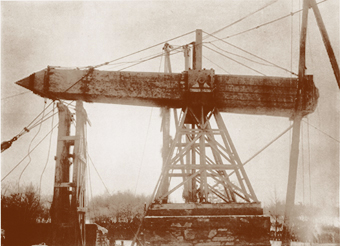- Egyptian Obelisk, a.k.a. “Cleopatra’s Needle”
- Date: created ca. 1461 BC; dedicated in Central Park 1881
- Medium & size: Granite, 71 feet high, 18 feet on each side; later base and steps about 27 feet high. Railing by Jacob Wrey Mould.
- Location: Central Park, west of the Metropolitan Museum of Art at 82nd St.
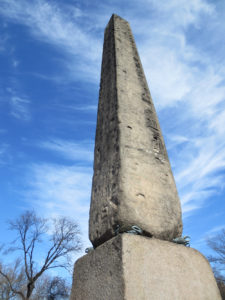
A word of warning: Reading about the obelisk is a reminder of how tricky it is to sort out fact from fiction, even in the pre-internet era. Its date, its dimensions, its condition, its reason for being in New York – you can get multiple versions of all of these from the New York Times archives and from scholarly books, never mind what you get when you add in the Net. I’ve used the information below that seems most likely.
Ancient History…
At 3500 years and counting, the Obelisk is by far the oldest man-made object in Central Park. Around 1450 BC, this 71-foot slab of granite was hewn out of bedrock for the Egyptian pharaoh Thutmose III. It was one of a pair guarding a temple at Heliopolis, near Cairo. Two hundred years later, Ramesses II – a man of monumental ego – had his own names and titles incised on it. The obelisk and its twin remained at Heliopolis for 1,500 years, through the rise and fall of a dozen pharaonic dynasties and a slew of foreign invasions.
Then Cleopatra, queen of Egypt (r. 52-31 BC), ordered the obelisks moved to Alexandria, to flank the entrance to a temple honoring her dead lover, Julius Caesar. Cleopatra committed suicide before the obelisks had been shifted, but her plan was carried out by Caesar’s great-nephew, Octavian Augustus. To keep the obelisk upright on its severely worn base, the Roman emperor commissioned a set of 900-pound bronze crabs incised with the date 12 BC. (Of course, they didn’t say “12 B.C.,” they said “In the 18th year of the Emperor.” )

… and Modern
Now we fast-forward to 1800 AD. The rulers of Egypt have realized that those crazy foreigners will happily accept chunks of old, beat-up stone in exchange for commercial and political favors. The French are given an obelisk in the 1830s. The British are given one of the Heliopolis twins in 1878 – like this one, it’s nicknamed “Cleopatra’s Needle.”
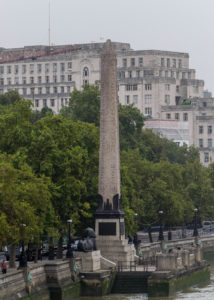
Americans are by this time catching up with Europe in industrial production, wealth, and military power. Many New Yorkers feel that an obelisk will help raise their city’s cultural level. After some fancy diplomatic footwork, the twin of London’s obelisk is given to the United States. After fierce debate, it’s decided to erect the obelisk in Central Park, rather than at the American Museum of Natural History or at the southeast or southwest corners of the Park.
William K. Vanderbilt, son of railroad-magnate Cornelius Vanderbilt, pays for the transportation of the obelisk. Henry Honychurch Gorringe devises a way to transport the more than 200-ton obelisk across the Atlantic. In June 1880, he supervises the loading of the obelisk into the hull of a steamship.
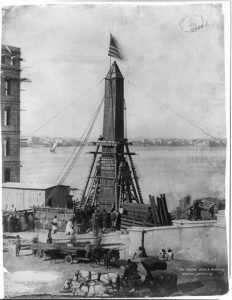
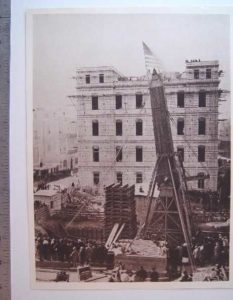
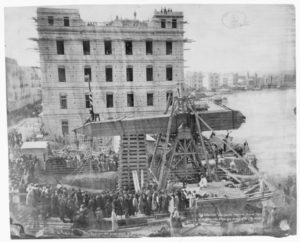
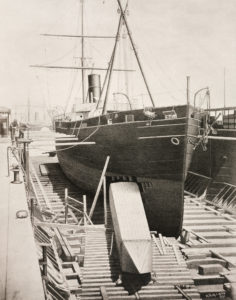
After the obelisk arrives in Staten Island a month later, Gorringe supervises its journey via barge to the west side of Manhattan. The trip from the pier across the island is via a specially built railroad line, and takes four times as long as the transatlantic leg. From the Central Park West via the 86th Street Transverse to Fifth Avenue takes nineteen days; from there to its present site, another twenty.
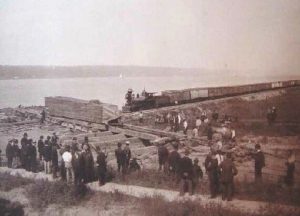
Suddenly there is obelisk fever in New York!
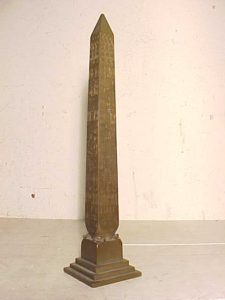

On a cold, snowy January day, thousands cheer as the Egyptian obelisk is hoisted upright in Central Park.
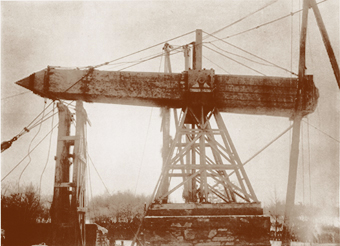
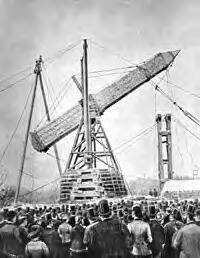

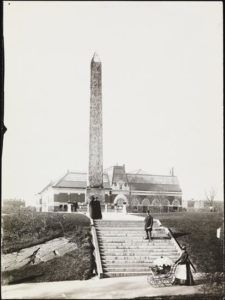
The Crabs
The crabs who supported the worn corners of the obelisk in Roman times are now in the Metropolitan Museum. The four replacements – each some 900 pounds of bronze – have inscriptions noting when the obelisk was moved to Alexandria, when it was transported to the United States, the names of President Rutherford B. Hayes and his secretary of State, and Gorringe as the engineer who supervised the transport and re-erection. The New York City Parks Department’s website includes these inscriptions plus translations of the hieroglyphic inscriptions.
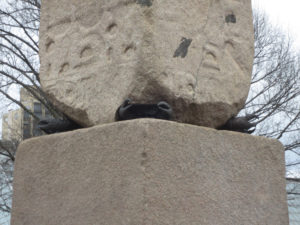
The Neo-Egyptian railing around the Obelisk is by Jacob Wrey Mould – the last of his many charming works in Central Park.
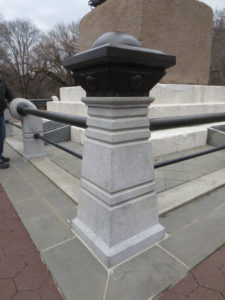
The New York Times on the Obelisk
The unidentified author of the article “Obelisks,” published in the New York TImes, October 29, 1879, has his tongue firmly in cheek:
There is no longer any hope that we shall escape the Alexandria obelisk. The contractor who has undertaken to bring it to New-York is already engaged in pulling it down, and, unless the elements interfere to wreck the vessel in which it is to be shipped, it will reach our shores, pass through the Custom-house, where it will be heavily taxed in order to protect homemade obelisks from foreign competition, and be finally set up in the Central Park, as a monument to – nobody knows what.
– New York TImes, October 29, 1879
The passion for removing Egyptian obelisks and erecting them in foreign countries, where they are meaningless and impertinent, is closely akin to the passion for painting one’s name on the pyramids or scratching it on the pillars of the Parthenon. An obelisk on the spot where the Egyptians placed it is an extremely interesting thing, but when John Smith paints his name on it, or buys it and carries it away to set it up in a European or American city, he does what in him lies to vulgarize it. …
While, as a matter of taste, there cannot be two opinions in regard to ther removal of the Egyptian obelisks from Egypt, very grave objections may be made to it in the interests of archaeology. In the dim future, the wide distribution of obelisks will give rise to a variety of conflicting but equally erroneous theories. No one in that remote and presumably intensely scientific age will believe that the Romans, the French, the English, and the Americans were guilty of carrying off obelisks. In the year 3000 there will be archaeologists who will insist that the obelisk-builders were a race that at one period extended over Europe, Africa, and America, and erected obelisks as milestones. Others will claim that the obelisks were not the work of human hands, but were produced by crystallization in the Polar regions, and were distributed over the earth by the action of glaciers during the glacial period. Reams of arguments will be written by the defenders of these rival theories – the former of which will doubtless be upheld by the believers in religion, while the latter will be supported by the Positivists. The religious archaeologists will trace a resemblance between the hieroglyphics of the engraved obelisks and the scratches made by the small boy of the present age on the sides of the school-house and its contiguous fences, and will thus strengthen his theory of the wide dispersion of the obelisk-building race. The Positivists will, of course, deny that the hieroglyphics prove the existence of conscious hieroglyphic-cutters, and will persist that crystallization determined the form of the obelisks, and that the grinding of their surfaces during the slow motion of the glaciers marked them with the so-called hieroglyphics.
Thus, the result of robbing Egypt of her obelisks will be the confusion of ethnology and archaeology and the kindling of the worst polemic passions of the future men of science. What right have we thus to remove the landmarks of archaeology, and sow ethnological tares for posterity to reap?
From the New York Times description of the dedication, January 23, 1881:
“The Obelisk in Position. Yesterday’s Ceremony in the Central Park. The Stone Pointing Heavenward, and All Ready to Be Secured to the Foundation – A Display of Marines.”
The original Egyptian and only American obelisk is at this moment standing erect in Central Park, stately and lonely, and very cold. … If it stands in the Central Park as long as it stood in the brick-yard behind the railroad station in Alexandria, it will no doubt see the Brooklyn bridge finished and the electric light almost perfected. …
For an hour before the time [noon] carriages were driving up the slushy no-thoroughfares of the Park, stopping on the edges of the grass and looking anxiously through the single eye in the back of their heads, waiting for the last sad rites to begin. Thirty or forty of the gray Park policemen were stationed in advantageous positions, to prevent people from making short cuts across and compel them to walk half a mile or so around the intricate walks that some cross-eyed landscape gardener had prepared for their edification. …
At five minutes past noon Lieut.-Commander Gorringe, who was standing just in front of the platform, waved his handkerchief, the Marine Band drums began to beat, and the point of the needle began to rise in the air. As the point rose, the base, of course, went down toward its place on the pedestal. It took about a minute with vigorous pulling at the ropes for the stone to reach an angle of 45 degrees. Then the men stopped pulling and Commander Gorringe shouted, “Go ahead with your photograph!” Then for the first time was seen a photographer with the usual three-legged machine and the usual black cloth. This unfortunate man was allowed about three-eighths of a second to secure his negative, and then the stone started again. …
It was precisely 12:14 when the obelisk reached the perpendicular, and if Cleopatra had been present she must have admitted that she could not have done the business better herself. …
New York Times, 1/23/1881
The Condition of the Obelisk
New York Times described the condition of the Obelisk on May 12, 1914. Their methods of “preservation” and plans to recut the inscriptions make me shudder.
“Obelisk, Scaling, Is to Be Recoated. Dr. Kuckro Will Apply His Newly Discovered Preservative for Stone. To Recut Inscriptions. Climatic Ravages Have Destroyed Hieroglyphics on Central Park’s Historic Curio.”
Park Commissioner Cabot Ward began restorative work yesterday on the Central Park obelisk, which recent investigations showed was threatened with disintegration unless some speedy measures were taken to preserve this sandstone of the Egyptian desert from the ravages of the elements. Large pieces have peeled off from the sides of the tall shaft, carrying away parts of the hieroglyphics. …
Many years ago at the suggestion of the late Prof. Ogden Doremus the Obelisk was treated with a coating of paraffin. This was repeated at intervals, and other remedies were tried too, but the chipping of the shaft continued. …
“During the first year following the erection of the Obelisk nothing was done to protect it from climatic changes, and it was more severely damaged during that period than in any one year since,” said Prof. Kemp yesterday. “To apply the paraffin it was necessary to heat the monolith to 140 or 150 degrees Fahrenheit. I do not know that this heating affected the shaft or had anything to do with its present bad condition, but it was the only way by which it could be treated with paraffin. The new process invented by Dr. Kuckro may be spread over the stone like paint. The tests I have made with the process show a tough coating, like rubber, completely waterproof, and which I believe will make a permanent preservative.”
The condition of the Obelisk was noted a few days ago when a park employe, Herman V. Letkemann, took a photograph of it. His lens showed the Obelisk to be scaling on all sides more than in any previous picture taken of it. Scales from six to twelve inches in diameter had dropped from the shaft. In some sections the shaft was blank for several feet, all the inscriptions being obliterated. …If the preservative proves apparently successful, Commissioner Ward expects to restore the monolith to its original appearance by recutting the hieroglyphics in the sections that have been destroyed. This work may be accomplished accurately from photographs taken when the shaft was brought here, when every character was clear-cut and well defined.
New York Times 5/12/1914
Here’s the New York Times on the latest cleaning: “For ‘Cleopatra’s Needle,’ a Cleaning to Last 500 Years,” by Lisa W. Foderaro, May 7, 2014.
Back in 2011, Zahi Hawass, the minister of Egypt’s Supreme Council of Antiquities at the time, threatened to take back the 193-ton granite obelisk known as Cleopatra’s Needle, which has stood in Central Park since 1881, because, he said, it was being neglected …
This week, after three years of planning, workers mounted the scaffolding surrounding the obelisk, [and] began to clean the surface with a laser, a method that was determined to be the safest for the monument. Soon, a special adhesive used in granite conservation will be applied to help stabilize the monument …
The deterioration of the obelisk had less to do with conditions in New York City than the fact that, at some point in its history, it had toppled over and lay in desert sands for 500 years, according to the [Metropolitan] Museum. …
Shortly after its arrival, the monument underwent a restoration that did as much harm as good, conservancy officials say. Workers coated the entire structure in parraffin, which did preserve the surface. But first they cleaned a little too aggressively, scraping off an estimated 700 pounds of granite. …
Lasers will remove a layer of dirt that has accumulated over the decades from the burning of fossil fuels. …
“The bottom line,” Mr. Blonsky [of the Central Park Conservancy] said, “is that when we’re done, you’ll come back in 500 years and this will look pretty much the way it looks today.”
“For ‘Cleopatra’s Needle,’ a Cleaning to Last 500 Years,” by Lisa W. Foderaro, May 7, 2014
More
- Henry Honychurch Gorringe is buried at Rockland Cemetery in Sparkill, NY, with a miniature copy of the Obelisk as his marker.
- A thought re damage to the Obelisk being from lying in sand and water or overzealous preservation efforts, rather than from New York City’s climate and pollution: like the Obelisk, the sculpture of Alexander Hamilton that stands just west of the Metropolitan Museum is granite. It was erected in 1880, just a year before the Obelisk was dedicated on its present site. Hamilton shows hardly any damage.
- For the story of Central Park in the 1850s-1870s, see my book Central Park: The Early Years.
- For early images of Central Park, see the pages on this site for through 1860, 1861-1865, and 1866-1870.
- In Getting More Enjoyment from Sculpture You Love, I demonstrate a method for looking at sculptures in detail, in depth, and on your own. Learn to enjoy your favorite sculptures more, and find new favorites. Available on Amazon in print and Kindle formats. More here.
- Want wonderful art delivered weekly to your inbox? Check out my free Sunday Recommendations list and rewards for recurring support: details here.
